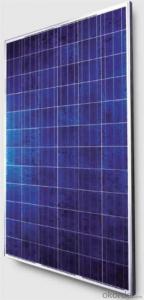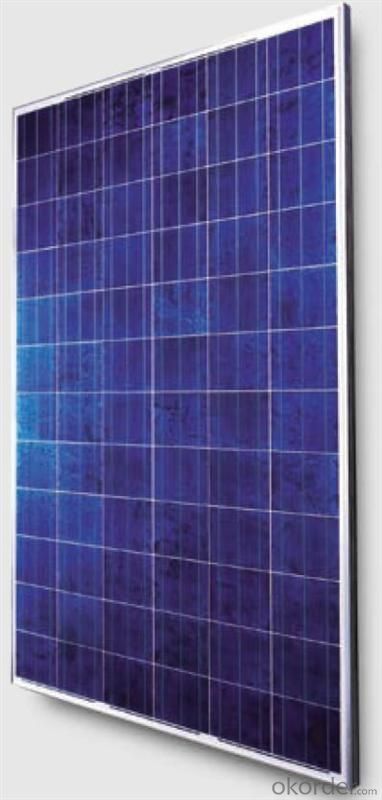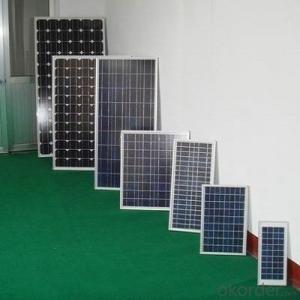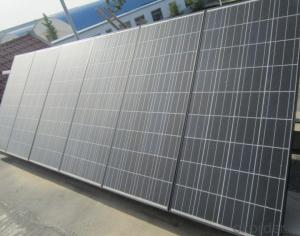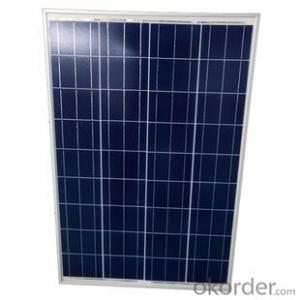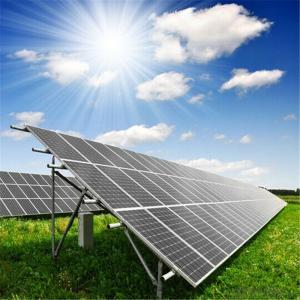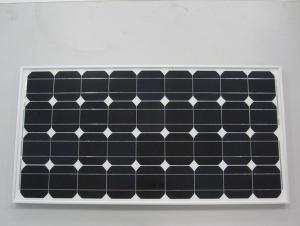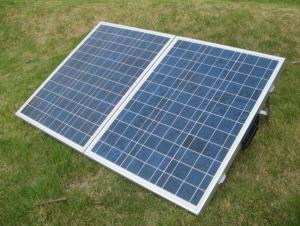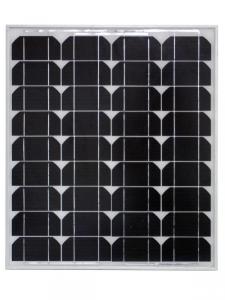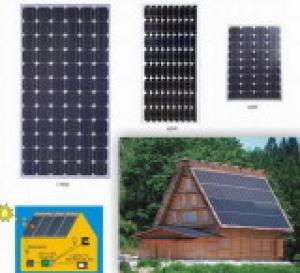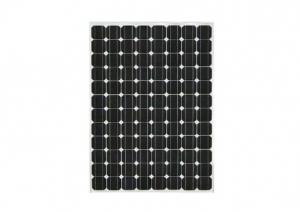Used Polycrystalline Solar Panels for 20kW Rooftop Systems
- Loading Port:
- Tianjin
- Payment Terms:
- TT OR LC
- Min Order Qty:
- 78000 watt
- Supply Capability:
- 10000000 watt/month
OKorder Service Pledge
OKorder Financial Service
You Might Also Like
CNBM Polycrystalline Solar Panels for 20kw Rooftop Systems
Solar modules use light energy (photons) from the sun to generate electricity through the photovoltaic effect. The majority of modules use wafer-based crystalline silicon cells or thin-film cells based on cadmium telluride or silicon. The structural (load carrying) member of a module can either be the top layer or the back layer. Cells must also be protected from mechanical damage and moisture. Most solar modules are rigid, but semi-flexible ones are available, based on thin-film cells. These early solar modules were first used in space in 1958.
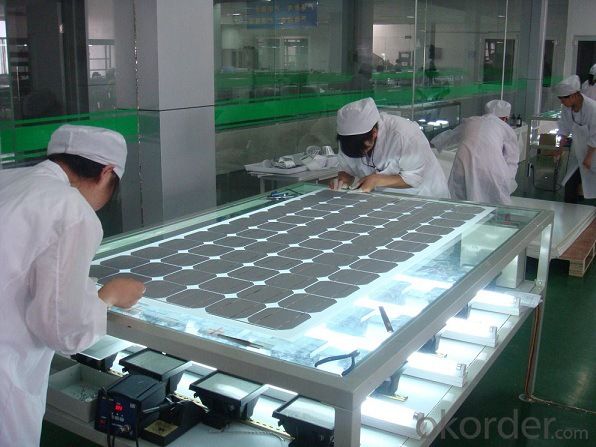
Specifications:
Electrical connections are made in series to achieve a desired output voltage and/or in parallel to provide a desired current capability. The conducting wires that take the current off the modules may contain silver, copper or other non-magnetic conductive transition metals. The cells must be connected electrically to one another and to the rest of the system. Externally, popular terrestrial usage photovoltaic modules use MC3 (older) or MC4 connectors to facilitate easy weatherproof connections to the rest of the system.
solar panels from 5W--300W, made of TAIWAN MOTECH brand cells,with CO in TAIWAN,Mono and Poly with VDE,IEC,CSA,UL,CE,ISO.
We import solar cells from Taiwan Motech brand, with this CO in taiwan and our CSA certification,we can still sell goods to Anti-dumping areas like USA. Our main products are solar panels, off grid and on grid solar home systems , solar street lighting systems, solar water heating system,solar pump,solar attic fan, solar DC LED lights and solar DC refrigerators.
Certificates : ISO, CE, VDE IEC, MCS, CSA-UL, CEC.
Delivery time: sample 10days, order 25-30days.
Sample: charged.
Payment term: T/T 30% as deposit, 70% before shipment. Or irrevocable L/C at sight.
Trade term: FOB Shenzhen or CIF destination seaport or Airport.
Characteristics:
I.Solar Cell : High efficiency crystalline solar cell. Even if under the weak light, the solar module can produce maximum power output.
II.Tempered glass (toughened glass): Anti-reflecting coating and high transmission rate glass increase the power output and mechanical strength of solar module.
III.EVA and TPT: Using high quality EVA and TPT to prevent destroying and water.
IV.AI frame: Without screw, corner connection. 6 holes on the frame can be installed easily.
V.Junction box: Multi function junction box with water proof.
VI.Long lifetime: ≥25 years; Less power decrease.
VII.Good performance of preventing from atrocious weather such as wind and hails.
VIII.Resisting moisture and etching effectively, not effected by geology.
IX.The certificate issued by international authority: UL, TUV, IEC, VDE, CE.
Quality and Safety
1. Rigorous quality control meets the highest international standards.
2. High-transmissivity low-iron tempered glass, strong aluminium frame.
3. Using UV-resistant silicon.
4. IS09001/14001/CE/TUV/UL
Warranties
1. 10 years limited product warranty
2. 15 years at 90% of the minimal rated power output
3. 25 years at 80% of the minimal rated power output
Technical date :
ITEM NO.: | Poly 156*156 cell ,60pcs . Power range from 230Wp-260Wp | ||||||
Maximum Power(W) | 230 | 235 | 240 | 245 | 250 | 255 | 260 |
Optimum Power Voltage(Vmp) | 29.4 | 29.5 | 29.7 | 30.1 | 30.3 | 30.5 | 30.7 |
Optimum Operatige Current(Imp) | 7.83 | 7.97 | 8.08 | 8.14 | 8.25 | 8.37 | 8.48 |
Open Circuit Voltage(Voc) | 36.7 | 36.8 | 36.9 | 37.1 | 37.3 | 37.5 | 37.7 |
Short Circuit Current(Isc) | 8.52 | 8.59 | 8.62 | 8.65 | 8.69 | 8.73 | 8.78 |
Solar Cell: | 156*156 Poly | ||||||
Number of Cell(pcs) | 6*10 | ||||||
Name of Solar Cells | Polycrystalline Cell | ||||||
Size of Module(mm) | 1650*992*40/45/50 | ||||||
Cable & Connector Type | Pass the TUV Certificate | ||||||
Frame(Material Corners,etc.) | Aluminium-alloy | ||||||
Back sheet | TPT | ||||||
Weight Per Piece(KG) | 19.5KG | ||||||
FF (%) | 70-76% | ||||||
Junction Box Type | Pass the TUV Certificate | ||||||
Tolerance Wattage(e.g.+/-5%) | ±3%, or 0-3% | ||||||
Front Glass Thickness(mm) | 3.2 | ||||||
Temperature Coefficients of Isc(%) | +0.04 | ||||||
Temperature Coefficients of Voc(%) | -0.38 | ||||||
Temperature Coefficients of Pm(%) | -0.47 | ||||||
Temperature Coefficients of Im(%) | +0.04 | ||||||
Temperature Coefficients of Vm(%) | -0.38 | ||||||
Temperature Range | -40°C to +85°C | ||||||
Surface Maximum Load Capacity | 5400Pa | ||||||
Allowable Hail Load | 23m/s ,7.53g | ||||||
Bypass Diode Rating(A) | 12 | ||||||
Warranty | 90% of 10 years, 80% of 25 years. | ||||||
Standard Test Conditions | AM1.5 1000W/ 25 +/-2°C | ||||||
Packing | carton or pallet | ||||||
1*20' | 14 Pallets / 316pcs | ||||||
1*40'STD | 25 Pallets / 700pcs | ||||||

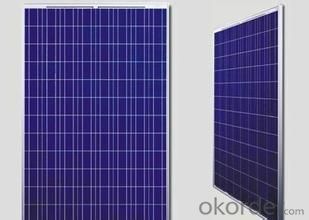
FAQ:
I..Will you focus on the safety of the goods during transportation?
Yes, Safety of the cargo is the primary element that we would consider on transportation.
II..How would guarantee the quality will meet the requirements of your clients?
Before shipment, we will have inspection for each batch of goods.
III..What certificates do you have?
IEC,UL,TUV,CSA,etc.
IV..Can you do OEM according to clients’ requirements?
Yes, we have our own brand while we can provide OEM service.
- Q: solar panel capacity, how do it work
- You can find a lot on the Internet about how solar panels work. See the links below. I'm not sure how you define capacity. Solar panels are made up of many solar cells. Each cell is capable of generating a low DC voltage while delivering a small current, Several cells are connected in series, making strings to develop the required voltage. Then many of these strings are connected in parallel, so the panel can deliver a usable current. Then the panels are connected in series and/or parallel to deliver a usable voltage and current. My panels are rated at 24 volts. 20 panels are connected in series to develop 480 volts. This is sent to an inverter, which converts the 480 volts DC to 20 volts AC
- Q: I want to install a solar panel on my car. I want to know that how much energy can be generated by a panel of size 4 foot by 6 foot. and the cost of installation.
- A little more than 0 watts per square foot, so that size panel would generate 250 watts under ideal conditions, which is noon on a sunny but not too hot day, near the equator. That's about /3 horsepower, or the same power as a man working hard. That is larger than needed to keep the battery of the car charged, unless you plan to run a laptop or something off it at night. The power is also too small to power the car for driving. If it's an electric car, you could get maybe another 2 miles per day out of the car, again, under ideal conditions. An RV store might have an idea of how much installation would cost. They would be accustomed to solar panels for RV's, but probably not small cars. A panel of that size would cost perhaps $500-800 just for the panel.
- Q: Are solar panels durable?
- Yes, solar panels are generally durable. They are designed to withstand harsh weather conditions, such as rain, snow, and wind. Additionally, they have a long lifespan, typically ranging from 25 to 30 years. However, the durability may vary depending on the quality of the panels and the installation process.
- Q: If a solar panel is a .5kW system, what length of time is it putting out that much power? Every hour?
- Solar panels are rated under standard test conditions (STC), a certain amount of light at a certain distance, at a certain temperature, etc. A kW, or kilo watt, is 000 watts. So for the amount of time that the sun meets those conditions, the rate of output is 500 watts. An average location has an average of 5 sun hours a day, the total time that you produce the rated output. Watts is a rate, like miles per hour (mph), how fast it is going. Watt hours, or kilo watt hours (kwh) is a quantity, like miles. So if you drive 50 mph for 5 hours, you went 250 miles (50 mph x 5 hours). If you produce .5kw for 5 hours, you have the potential to produce 7.5kwh a day. Multiply that by 30 days in a month, you get 225kwh a month. In reality you will lose about 30% of the rated power from less than ideal weather, system losses, etc., so it's more like 50kwh a month. You can look at your electric bill to see how many kwh you use a month, maybe around 000kwh, and see what percentage of your usage a system like that can power.
- Q: Can solar panels be used in areas with high pollution or smog?
- Yes, solar panels can be used in areas with high pollution or smog. While pollution or smog can reduce the efficiency of solar panels by blocking sunlight, they can still generate electricity even under such conditions. However, the overall energy output may be slightly lower compared to areas with less pollution or smog.
- Q: About how much would it cost to purchase and install solar panels for the average American house so that the house can be off the power grid and use the same amount of electricity as it normally does?
- And even though the better technology is out there, it is not in mass production. Perhaps one day it will be, but it is not there presently Silicon wafer based solar cells Despite the numerous attempts at making better solar cells by using new and exotic materials, the reality is that the photovoltaics market is still dominated by silicon wafer-based solar cells (first-generation solar cells). This means that most solar cell manufacturers are equipped to produce these type of solar cells. Therefore, a large body of research is currently being done all over the world to create silicon wafer-based solar cells that can achieve higher conversion efficiency without an exorbitant increase in production cost. The aim of the research is to achieve the lowest $/watt solar cell design that is suitable for commercial production.
- Q: Do solar panels require regular cleaning?
- Yes, solar panels do require regular cleaning to ensure optimal performance. Dust, dirt, and other debris can accumulate on the surface of the panels over time, blocking sunlight and reducing their efficiency. Regular cleaning helps to remove these obstructions and maximize the energy output of the solar panels.
- Q: Can solar panels be used for irrigation systems?
- Yes, solar panels can be used to power irrigation systems. Solar energy can be harnessed by the panels and converted into electricity, which can then be used to run pumps and other components of an irrigation system. This renewable energy source offers a sustainable and cost-effective solution for powering irrigation systems, especially in remote or off-grid areas.
- Q: I want to put a solar panel(s) on my roof. What components do I need besides the solar panels? solar power controller? wires? How do I hook it into my home's electrical system and about how much electricity could I generate and save? Would the panels pay for themselves over time? Any help will be appreciated. Thank you!
- Solar water heating panels are often heavy, depending on their design. Solar electric panels are rarely heavy - at mabye 3 lbs. per square foot, including mounting racks, they are not much heavier than typical roofing materials. Whether the panels pay for themselves is a highly individualized answer, dependent on your state and local rebates (if any), how much sun your area gets, and the cost of your electricity. Just about any Californian can break even, but it can take 5-20 years. Prices are dropping, so this should get better next year (but federal tax credits expire - could be renewed, a Democratic president would be unlikely to veto). A house that is conservative in electrical usage (this usually means no air conditioners in the summer or electric heat in the winter) generally has enough roof area to supply 00% of its electrical needs. We have 0% of our roof dedicated to panels, and it supplies essentially 00% for us. The best way to get answers to your questions is to ask a few solar companies to do a free analysis and quote on your house. You can always say no. If you're thinking of doing it yourself, that's possible, but not trivial. It's also possible that a professional could install it for less than you could if you bought the parts yourself and installed it yourself. We installed our own, but the experience is a little dated - from 2006. There's a video at the bottom of the page below, if you want to see what we did.
- Q: China is the world's biggest producer of solar panels
- Go ahead admit it...Carter was right ! He was right in seeking to raise the fleet auto mileage standard to 48 miles per gallon by 995. (Even U.S. automakers admitted at the time that they could easily achieve 30 mpg by 985.) Carter was right in exhorting Americans to turn down their thermostats, even if he did look nerdy in a cardigan while urging us to do so. He was right to encourage fuel conservation by proposing a 50-cents-per-gallon tax on gasoline and a fee on imported oil —- in effect, a floor for fuel prices. Invoking the pioneering spirit of the 960s moon mission, he was right to recommend a tax on windfall oil profits to finance a crash program to develop affordable synthetic fuels. Carter was correct, too, in setting a goal of obtaining 20 percent of our energy from solar power by the year 2000. The solar panels Carter put up on the Whitehouse were USA made. The solar
Send your message to us
Used Polycrystalline Solar Panels for 20kW Rooftop Systems
- Loading Port:
- Tianjin
- Payment Terms:
- TT OR LC
- Min Order Qty:
- 78000 watt
- Supply Capability:
- 10000000 watt/month
OKorder Service Pledge
OKorder Financial Service
Similar products
Hot products
Hot Searches
Related keywords
